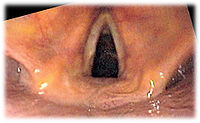
Photo from wikipedia
OBJECTIVE In this study, our objective was to investigate whether video laryngoscopy has any advantage over direct laryngoscopy. METHODS This prospective study was conducted on an experimental research simulator after… Click to show full abstract
OBJECTIVE In this study, our objective was to investigate whether video laryngoscopy has any advantage over direct laryngoscopy. METHODS This prospective study was conducted on an experimental research simulator after the obtainment of the approval of the Ethics Committee. The study was conducted on the manikin Airsim Advance Combo. The volunteers were asked to carry out video laryngoscopy and direct laryngoscopy in both easy and difficult airway These variables were compared with the Wilcoxon test. We used the Mann-Whitney U test for the evaluation of the differences between the anesthetists and anesthesia technicians regarding the duration of the intubation. The accepted limit of significance was p < 0.05. RESULTS 24 volunteer anesthetists and anesthesia technicians were included in the study. After the statistical analysis, we did not detect any significant difference between the duration of direct intubation regarding the easy and difficult airway (p > 0.05).The statistical analysis did not reveal any significant difference between the laryngoscopy methods also in the difficult airway model (p > 0.05). CONCLUSION We showed on a simulator that there was no statistically significant difference between the duration of the intubation between direct laryngoscopy and video laryngoscopy both in the easy and difficult airway.
Journal Title: Journal of the National Medical Association
Year Published: 2020
Link to full text (if available)
Share on Social Media: Sign Up to like & get
recommendations!